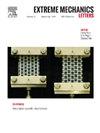Mechanics of bonded sensor layers in soft tubes: Suppressing instability and failure for sensing reliability
IF 4.5
3区 工程技术
Q2 MATERIALS SCIENCE, MULTIDISCIPLINARY
引用次数: 0
Abstract
Integrating sensors onto thin-walled tubular structures is of paramount importance for the advancement of smart infrastructures and facilities, enabling real-time detection of mechanical states and environmental conditions. This study systematically investigates the mechanics of bonded sensor layers in suppressing bending-induced ovalization, buckling, and failure in soft, thin-walled tubes, with the goal of enhancing sensing reliability. While significant progress has been made in understanding instability phenomena in tubular structures under mechanical loading, a critical gap remains in characterizing how bonded sensor layers influence deformation and failure mechanisms. To address this, a comprehensive parametric analysis—supported by finite element simulations and experimental validation—was conducted to evaluate the effects of four key parameters: length ratio, thickness ratio, wrapped angle, and relative stiffness. The results reveal that optimized configurations—specifically, length ratios exceeding 0.7, thickness ratios above 1.6, moderate wrapped angles (approximately 2π/3–4π/3), and relative stiffness greater than 0.03—can suppress ovalization to below 25 % in sensor-covered regions, redistribute deformation to uncovered segments, and trigger complex buckling behaviors involving multiple kinks and secondary instabilities. These thresholds mitigate localized strain concentrations, reduce the risk of sensor layer wrinkling or delamination, and preserve measurement fidelity under operational loading. The findings extend classical instability theories to hyperelastic, multilayered systems and provide practical design guidelines for sensor-integrated tubular structures. Applications include smart pipelines and conduits for structural health monitoring and environmental sensing in next-generation infrastructure systems.
软管中键合传感器层的力学:抑制不稳定性和失效对传感可靠性的影响
将传感器集成到薄壁管状结构上对于智能基础设施和设施的发展至关重要,可以实时检测机械状态和环境条件。本研究系统地研究了在软薄壁管中粘结传感器层抑制弯曲引起的椭圆化、屈曲和失效的力学,目的是提高传感器的可靠性。虽然在理解管状结构在机械载荷下的不稳定现象方面取得了重大进展,但在表征粘结传感器层如何影响变形和破坏机制方面仍然存在关键差距。为了解决这个问题,在有限元模拟和实验验证的支持下,进行了全面的参数分析,以评估四个关键参数的影响:长度比、厚度比、包裹角和相对刚度。结果表明,优化后的结构——长度比大于0.7,厚度比大于1.6,包裹角适中(约2π/3 - 4π/3),相对刚度大于0.03——可以抑制传感器覆盖区域的椭圆化至25 %以下,将变形重新分配到未覆盖的部分,并触发包括多重扭结和二次失稳在内的复杂屈曲行为。这些阈值减轻了局部应变浓度,降低了传感器层起皱或分层的风险,并保持了工作负载下测量的保真度。这些发现将经典的不稳定性理论扩展到超弹性、多层系统,并为传感器集成管状结构提供了实用的设计指南。应用包括下一代基础设施系统中用于结构健康监测和环境传感的智能管道和导管。
本文章由计算机程序翻译,如有差异,请以英文原文为准。
求助全文
约1分钟内获得全文
求助全文
来源期刊

Extreme Mechanics Letters
Engineering-Mechanics of Materials
CiteScore
9.20
自引率
4.30%
发文量
179
审稿时长
45 days
期刊介绍:
Extreme Mechanics Letters (EML) enables rapid communication of research that highlights the role of mechanics in multi-disciplinary areas across materials science, physics, chemistry, biology, medicine and engineering. Emphasis is on the impact, depth and originality of new concepts, methods and observations at the forefront of applied sciences.
 求助内容:
求助内容: 应助结果提醒方式:
应助结果提醒方式:


